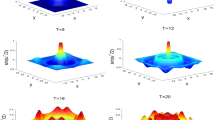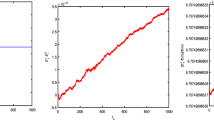Abstract
In this study, firstly, a sixth-order finite difference operator and correction technique of truncation error remainder are employed to construct a nonlinear high-order finite difference scheme and a linearized high-order finite difference scheme for solving the numerical solution of two-dimensional nonlinear wave equations with variable coefficients. Both new schemes have sixth-order accuracy in space and fourth-order accuracy in time. Then, the Richardson extrapolation technique is applied to obtain a numerical solution of sixth-order accuracy in both time and space. Meanwhile, the stability of the corresponding difference scheme for the linear wave equation is proved by Fourier analysis. In addition, two proposed sixth-order schemes are extended to solve the coupled sine-Gordon equations. Finally, some numerical experiments are presented to confirm the effectiveness and accuracy of the proposed schemes.







Similar content being viewed by others
Data Availability
The data used to support the findings of this study are available from the corresponding author upon request.
References
Drazin, P.J., Johnson, R.S.: Solitons: An Introduction. Cambridge University Press, Cambridge (1989)
Biswas, A.: Soliton perturbation theory for phi-four model and nonlinear Klein–Gordon equations. Commun. Nonlinear Sci. Numer. Simul. 14, 3239–3249 (2009)
Sun, Y.: New exact traveling wave solutions for double sine-Gordon equation. Appl. Math. Comput. 258, 100–104 (2015)
Jiwari, R., Pandit, S., Mittal, R.C.: Numerical simulation of two-dimensional sine-Gordon solitons by differential quadrature method. Comput. Phys. Commun. 183, 600–616 (2012)
Barbu, V., Pavel, N.H.: Periodic solutions to nonlinear one dimensional wave equation with x-dependent coefficients. Trans. Am. Math. Soc. 349, 2035–2048 (1997)
Abdelsalam, S.I., Bhatti, M.M.: Anomalous reactivity of thermo-bioconvective nanofluid towards oxytactic microorganisms. Appl. Math. Mech. 41, 711–724 (2020)
Abdelsalam, S.I., Sohail, M.: Numerical approach of variable thermophysical features of dissipated viscous nanofluid comprising gyrotactic microorganisms. Pramana 94, 1–12 (2020)
Deng, D., Liang, D.: The time fourth-order compact ADI methods for solving two-dimensional nonlinear wave equations. Appl. Math. Comput. 329, 188–209 (2018)
Zabusky, N.J., Kruskal, M.D.: Interaction of “Solitons’’ in a collisionless plasma and the recurrence of initial states. Phys. Rev. Lett. 15, 240–243 (1965)
Jagtap, A.D.: On spatio-temporal dynamics of sine-Gordon soliton in nonlinear non-homogeneous media using fully implicit spectral element scheme. Appl. Anal. 100(1), 37–60 (2019)
Wazwaz, A.M.: Exact solutions for the generalized sine-Gordon and the generalized sine-Gordon equations. Chaos. Soliton. Fract. 28, 127–135 (2006)
Aktosun, T., Demontis, F., Der Mee, C.V.: Exact solutions to the sine-Gordon equation. J. Math. Phys. 51, 123521 (2010)
Zhou, Q., Ekici, M., Mirzazadeh, M., Sonmezoglu, A.: The investigation of soliton solutions of the coupled sine-Gordon equation in nonlinear optics. J. Morden Opt. 64(16), 1677–1682 (2017)
Belayeh, W.G., Mussa, Y.O., Gizaw, A.K.: Approximate analytic solutions of two-dimensional nonlinear Klein–Gordon equation by using the reduced differential transform method. Math. Probl. Eng. 2020, 5753974 (2020)
Deresse, A.T., Mussa, Y.O., Gizaw, A.K.: Analytical solution of two-dimensional sine-Gordon equation. Adv. Math. Phys. 2021, 6610021 (2021)
**e, S., Yi, S., Kwon, T.I.: Fourth-order compact difference and alternating direction implicit schemes for telegraph equations. Comput. Phys. Commun. 183, 552–569 (2012)
Deng, D., Zhang, C.: A new fourth-order numerical algorithm for a class of nonlinear wave equations. Appl. Numer. Math. 62, 1864–1879 (2012)
Deng, D., Zhang, C.: Analysis and application of a compact multistep ADI solver for a class of nonlinear viscous wave equations. Appl. Math. Model. 39, 1033–1049 (2015)
Deng, D.: Unified compact ADI methods for solving nonlinear viscous and nonviscous wave equations. Chin. J. Chem. Phys. 56, 2897–2915 (2018)
Cui, M.: High order compact alternating direction implicit method for the generalized sine-Gordon equation. J. Comput. Appl. Math. 235, 837–849 (2010)
Hou, B., Liang, D.: The energy-preserving time high-order AVF compact finite difference scheme for nonlinear wave equations in two dimensions. Appl. Numer. Math. 170, 298–320 (2021)
Li, L., Sun, H., Tam, S.: A spatial sixth-order alternating direction implicit method for two-dimensional cubic nonlinear Schrödinger equations. Comput. Phys. Commun. 187, 38–48 (2015)
Darani, M.A.: The RBF partition of unity method for solving the Klein–Gordon equation. Eng. Comput. 38, 679–691 (2022)
Argyris, J., Haase, M., Heinrich, J.C.: Finite element approximation to two-dimensional sine-Gordon solitons. Comput. Methods Appl. Mech. Eng. 86, 1–26 (1991)
Shi, D., Pei, L.: Nonconforming quadrilateral finite element method for a class of nonlinear sine-Gordon equations. Appl. Math. Comput. 219, 9447–9460 (2013)
Khusnutdinova, K.R., Pelinovsky, D.E.: On the exchange of energy in coupled Klein–Gordon equations. Wave Mot. 38, 1–10 (2003)
Ilati, M., Dehghan, M.: The use of radial basis functions (RBFs) collocation and RBF-QR methods for solving the coupled nonlinear sine-Gordon equations. Eng. Anal. Bound. Elem. 52, 99–109 (2015)
Deng, D.: Numerical simulation of the coupled sine-Gordon equations via a linearized and decoupled compact ADI method. Numer. Funct. Anal. Optim. 40(9), 1053–1079 (2019)
Deng, D., Liang, D.: The energy-preserving finite difference methods and their analyses for system of nonlinear wave equations in two dimensions. Appl. Numer. Math. 151, 172–198 (2020)
Deng, D., Wu, Q.: The studies of the linearly modified energy-preserving finite difference methods applied to solve two-dimensional nonlinear coupled wave equations. Numer. Algorithms. 88, 1875–1914 (2021)
Nawaz, Y., Arif, M.S., Shatanawi, W., Nazeer, A.: An explicit fourth-order compact numerical scheme for heat transfer of boundary layer flow. Energies 14(12), 3396 (2021)
Bourchtein, A., Bourchtein, L.: Explicit finite difference schemes with extended stability for advection equations. J. Comput. Appl. Math. 236(15), 3591–3604 (2012)
Li, K., Liao, W.: An efficient and high accuracy finite-difference scheme for the acoustic wave equation in 3D heterogeneous media. J. Comput. Sci. 40, 101063 (2020)
Balam, R.I., Zapata, M.U.: A new eighth-order implicit finite difference method to solve the three-dimensional Helmholtz equation. Comput. Math. Appl. 80(5), 1176–1200 (2020)
Wang, Z., Ge, Y., Sun, H., Sun, T.: Sixth-order quasi-compact difference schemes for 2D and 3D Helmholtz equations. Appl. Math. Comput. 431, 127347 (2022)
Lele, S.K.: Compact finite difference schemes with spectral-like resolution. J. Comput. Phys. 103, 16–42 (1992)
Yang, D.: Iterative Solution for Large Linear System. Academic Press, New York (1991)
Deng, D., Wu, Q.: Error estimations of the fourth-order explicit Richardson extrapolation method for two-dimensional nonlinear coupled wave equations. Comput. Appl. Math. (2022). https://doi.org/10.1007/s40314-021-01701-5
Zhang, G.: Two conservative and linearly-implicit compact difference schemes for the nonlinear fourth-order wave equation. Appl. Math. Comput. 401, 126055 (2021)
Achouri, T., Kadri, T., Omrani, K.: Analysis of finite difference schemes for a fourth-order strongly damped nonlinear wave equations. Comput. Math. Appl. 82, 74–96 (2021)
Wu, M., Jiang, Y., Ge, Y.: An accurate and efficient local one-dimensional method for the 3D acoustic wave equation. Demonstr. Math. 55, 528–552 (2022)
Acknowledgements
We would like to thank the editors and the referees whose constructive comments and suggestions are helpful to improve the quality of this paper. This work is partially supported by National Natural Science Foundation of China (12161067, 11772165, 11961054, 11902170), Natural Science Foundation of Ningxia (2022AAC02023, 2020AAC03059), the Key Research and Development Program of Ningxia (2018BEE03007), National Youth Top-notch Talent Support Program of Ningxia and the First Class Discipline Construction Project in Ningxia Universities: Mathematics.
Author information
Authors and Affiliations
Corresponding author
Ethics declarations
Conflict of interest
The authors declare no conflict of interest.
Additional information
Publisher's Note
Springer Nature remains neutral with regard to jurisdictional claims in published maps and institutional affiliations.
Appendix A
Appendix A
Taking the Taylor series expansion yields
Adding \({u_{i + 1}}\) and \({u_{i - 1}}\) in (A.1) and \({u_{i + 2}}\) and \({u_{i - 2}}\) in (A.2) gives
Put (A.4)–(A.3) \(\times 16\), we obtain
In the same way, we can get (A.4)–(A.3) \(\times 64\)
Define the following difference operator:
(A.5) and (A.6) can be rewritten as:
Substituting (A.9) into (A.10), we have
Rights and permissions
Springer Nature or its licensor (e.g. a society or other partner) holds exclusive rights to this article under a publishing agreement with the author(s) or other rightsholder(s); author self-archiving of the accepted manuscript version of this article is solely governed by the terms of such publishing agreement and applicable law.
About this article
Cite this article
Wang, S., Ge, Y. Efficient sixth-order finite difference method for the two-dimensional nonlinear wave equation with variable coefficient. Math Sci 18, 257–273 (2024). https://doi.org/10.1007/s40096-022-00498-6
Received:
Accepted:
Published:
Issue Date:
DOI: https://doi.org/10.1007/s40096-022-00498-6




